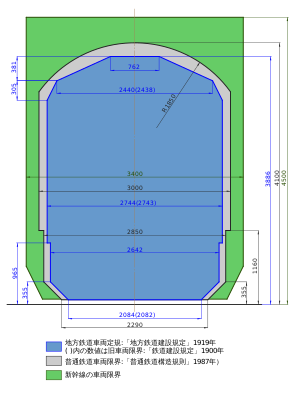Chinese railway signalling
Railway signals in China are based on OSShD signals[1] used by 25 countries of the former USSR, eastern Europe and adjacent countries. There are four observer countries.[2][3]
Overview[]
This section needs expansion. You can help by . (July 2020) |
Railway signals in China:[4]
Semaphore[]
Semaphore signals based somewhat on British practice. Use Red and White home signals, and Yellow and Black distant signals.[5]
Apart from Red=Halt and single G=Clear, the lights of a semaphore signal at night do not match match their colour light equivalents. There also more colour light aspects than semaphore aspects.
Colourlight[]
Colour lights: single green means full speed on straight, red means stop, with remainder meaning something in between.[6]
In China, double green is a more restrictive aspect than single green. If one of the green lamps fails, a less restrictive aspect is displayed which is potentially dangerous. Because of that lamp proving is necessary.
Standards exported[]
China is building or has built new standard gauge railways in Africa, and these are being built to Chinese standards, which in turn apply the standards of OSShD and other companies and businesses.
- Ethiopia & Djibouti
- Kenya
- Tanzania (influencing)
- Nigeria
Railway specifications[]
In general, the railway specifications are based on the Chinese National Railway Class 2 Standard.[7] However, with explicit demand by the Ethiopian Railway Corporation, some changes were made and adapted, which do not fit the Chinese standard, such as double stacking.
The railway characteristics were first specified and used for the Addis Ababa–Djibouti Railway and in many cases had to be used for other railways as well to keep the installations compatible with each other. Trains should be able to use different railways without having to switch locomotives (as an example). The most straightforward example of compatibility is, that there is no break-of-gauge. The first railway was standard gauge, so all following railways also had to be standard gauge. The power supply had to be the same for all railways, the train protection system as well.
In the following, common features and specifications of all railways are shown. If there are differences between railways, this is indicated by a range given for values:
- Gauge: Standard gauge (Britain)
- Couplers: Janney AAR (America)
- Brakes: Air Westinhouse (America)
- Electrification: Overhead catenary 25 kV AC / 50 Hz (France)
- Target speed (passenger): 120 km/h (75 mph)[citation needed]
- Target speed (freight): 80–90 km/h (50–56 mph)
- Maximum train load (freight): 3,000–3,500 tonnes (3,000–3,400 long tons; 3,300–3,900 short tons) gross[8]
- Designed transport capacity: 10-20 million tonnes annually[citation needed]
- Length of arrival & departure track at passing loops: 850 m (dual locomotive: 880 m) [resulting max. train length ~800 m][citation needed]
- Minimum railway curve radius: 800–1,200 m (2,600–3,900 ft) [600–800 m (2,000–2,600 ft) at difficult locations][citation needed]
- Maximum (ruling) gradient: 1.85-2.65 %[citation needed]
- Maximum vehicle loading gauge height: 5300 mm[citation needed]
- Trains run on the: Left (Britain)
- Railway signalling: semi-automatic block[citation needed] or automatic block[citation needed]
- Train protection system: ETCS-2 SIL4[9]
- Level crossings: permitted (no full grade separation)
- The loading gauge width for new standard gauge railways in Africa is 3,400 mm (11 ft 2 in) the same as the original Shinkansen in Japan, and copied by China, South Korea, Ethiopia, Kenya and possibly Tanzania and Nigeria.


Other countries[]
References[]
- ^ Organisation for the Combined Operations of Railways
- ^ OSShD
- ^ China signal aspects
- ^ Semaphore and Colourlight
- ^ Semaphore signals
- ^ Red Yellows and Greens
- ^ "首条全套"中国标准"电气化铁路非洲铺轨竣工_新闻中心_专题专栏_走出去_国际业务动态_中国铁建股份有限公司" [The first full set of "China Standard" completed the laying of African railways electrified railway] (in Chinese). 中国铁建股份有限公司 (China Railway Construction Co., Ltd.). Archived from the original on 5 November 2016. Retrieved 11 January 2017.
- ^ "Waldia/Hara Gebeya – Mekele Railway Project Basic Design / Route". China Communications Construction Company Ltd. Retrieved 15 January 2018.
- ^ "Zhejiang company provides control system for Ethiopia-Djibouti railway". United S&T. 2 November 2016.
TÜV Rheinland certified United's BiLOCK interlocking control system as a full ETCS-2 SIL4 system
- Railway signalling in China